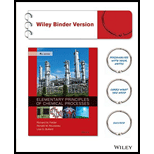
A small pharmaceutical firm plans to manufacture a new drug and has hired you as a consultant to design a condenser to remove the drug from a gas-vapor mixture. The mixture, which contains 20 mole% of the drug and the balance nitrogen, will be fed to the condenser at 510 K and 1 atm at a rate of 3.5 L/s. Of the drug fed to the unit, 90% must be condensed. No physical property data are available for the drug, and part of your job is to acquire the data needed to design the condenser. The company has sent you a large sample of the liquid drug for this purpose.
You acquire an insulated 2.000-liter container with a known heat capacity and a built-in electrical heating coil that can deliver a known heat input to the contents of the container. A calibrated thermocouple is used to measure the temperature in the vessel, and the pressure is measured with a mercury manometer.
You carry out a series of experiments on a day when atmospheric pressure is 763 mm Hg. Experiment 1. Fill the container with the liquid, then seal and weigh.
mass of container + liquid = 4.4553 kg mass of evacuated container = 3.2551 kg
Next, starting at each of two temperatures (
To= 283.0 K,
Assume that the liquid heat capacity may be expressed as a linear function of temperature (Cv= aT + b) when analyzing these results.
Experiment 2. Pour a small quantity of the drug into the container, place the container in a liquid nitrogen bath to freeze the drug, evacuate all of the air. and seal the container. Weigh the container after it comes back to room temperature.
mass of container + drug = 3.2571 kg
Next heat the scaled container until all of the liquid evaporates, and repeat Experiment 1.
Assume that the vapor heat capacity may be expressed as a linear function of temperature when analyzing these results.
Experiment 3. Fill approximately half the container with the drug, freeze, evacuate the air. and seal. Measure the pressure at several temperatures, verifying that liquid is present in the container at each temperature.
Using the given data, determine the following physical properties of the drug: (i) liquid specific gravity, (ii) molecular weight, (iii) linear expressions for the heat capacities at constant volume [in J/(mol·K)] for both the liquid and vapor
- , (iv) linear expressions for Cpfor both liquid and vapor, (v) a Clausius-Clapeyron expression for p*(T), (vi) the normal boiling point, and (vii) the heat of vaporization (in J/mol) at the normal boiling point.
Want to see the full answer?
Check out a sample textbook solution
Chapter 8 Solutions
Elementary Principles of Chemical Processes, Binder Ready Version
Additional Engineering Textbook Solutions
Process Dynamics and Control, 4e
Elements of Chemical Reaction Engineering (5th Edition) (Prentice Hall International Series in the Physical and Chemical Engineering Sciences)
Prelude to Programming
Problem Solving with C++ (10th Edition)
C Programming Language
Java: An Introduction to Problem Solving and Programming (7th Edition)
 Introduction to Chemical Engineering Thermodynami...Chemical EngineeringISBN:9781259696527Author:J.M. Smith Termodinamica en ingenieria quimica, Hendrick C Van Ness, Michael Abbott, Mark SwihartPublisher:McGraw-Hill Education
Introduction to Chemical Engineering Thermodynami...Chemical EngineeringISBN:9781259696527Author:J.M. Smith Termodinamica en ingenieria quimica, Hendrick C Van Ness, Michael Abbott, Mark SwihartPublisher:McGraw-Hill Education Elementary Principles of Chemical Processes, Bind...Chemical EngineeringISBN:9781118431221Author:Richard M. Felder, Ronald W. Rousseau, Lisa G. BullardPublisher:WILEY
Elementary Principles of Chemical Processes, Bind...Chemical EngineeringISBN:9781118431221Author:Richard M. Felder, Ronald W. Rousseau, Lisa G. BullardPublisher:WILEY Elements of Chemical Reaction Engineering (5th Ed...Chemical EngineeringISBN:9780133887518Author:H. Scott FoglerPublisher:Prentice Hall
Elements of Chemical Reaction Engineering (5th Ed...Chemical EngineeringISBN:9780133887518Author:H. Scott FoglerPublisher:Prentice Hall
 Industrial Plastics: Theory and ApplicationsChemical EngineeringISBN:9781285061238Author:Lokensgard, ErikPublisher:Delmar Cengage Learning
Industrial Plastics: Theory and ApplicationsChemical EngineeringISBN:9781285061238Author:Lokensgard, ErikPublisher:Delmar Cengage Learning Unit Operations of Chemical EngineeringChemical EngineeringISBN:9780072848236Author:Warren McCabe, Julian C. Smith, Peter HarriottPublisher:McGraw-Hill Companies, The
Unit Operations of Chemical EngineeringChemical EngineeringISBN:9780072848236Author:Warren McCabe, Julian C. Smith, Peter HarriottPublisher:McGraw-Hill Companies, The





